Analysis of Family and Domestic Violence Programs in Australia
VerifiedAdded on 2022/08/21
|21
|6504
|15
Report
AI Summary
This report analyzes various programs aimed at reducing vulnerability and building resilience in communities affected by family and domestic violence in Australia. It examines several articles and reports, including those by Dunkley & Phillips, Child Family Community Australia, Federation of Ethnic Communities' Councils of Australia, inTouch Multicultural Centre Against Family Violence, The National Advocacy Group on Women and their Children on Temporary Visas Experiencing Violence, and Nafiseh Ghafournia & Patricia Easteal. The report highlights the prevalence of domestic violence, the vulnerability of women and children (especially those on temporary visas or from culturally and linguistically diverse backgrounds), and the need for comprehensive support systems. Key themes include the impact of gender inequality, risk factors like substance abuse and childhood trauma, and the importance of providing legal, health, educational, and social support. The report emphasizes the need for improved migration policies, culturally competent services, and long-term accommodations to protect victims and build their resilience. The report also addresses the specific challenges faced by women on temporary visas, including fear of deportation and language barriers, and suggests policy recommendations to enhance their safety and security. The report concludes by advocating for increased government support and the implementation of programs designed to reduce vulnerability and promote resilience within affected communities.

Running head: FAMILY AND DOMESTIC VIOLENCE PROGRAMS FOR REDUCING
VULNERABILITY AND BUILDING RESILIENCE IN COMMUNITIES
FAMILY AND DOMESTIC VIOLENCE PROGRAMS FOR REDUCING
VULNERABILITY AND BUILDING RESILIENCE IN COMMUNITIES
Name of the Student
Name of the University
Author Note
VULNERABILITY AND BUILDING RESILIENCE IN COMMUNITIES
FAMILY AND DOMESTIC VIOLENCE PROGRAMS FOR REDUCING
VULNERABILITY AND BUILDING RESILIENCE IN COMMUNITIES
Name of the Student
Name of the University
Author Note
Paraphrase This Document
Need a fresh take? Get an instant paraphrase of this document with our AI Paraphraser
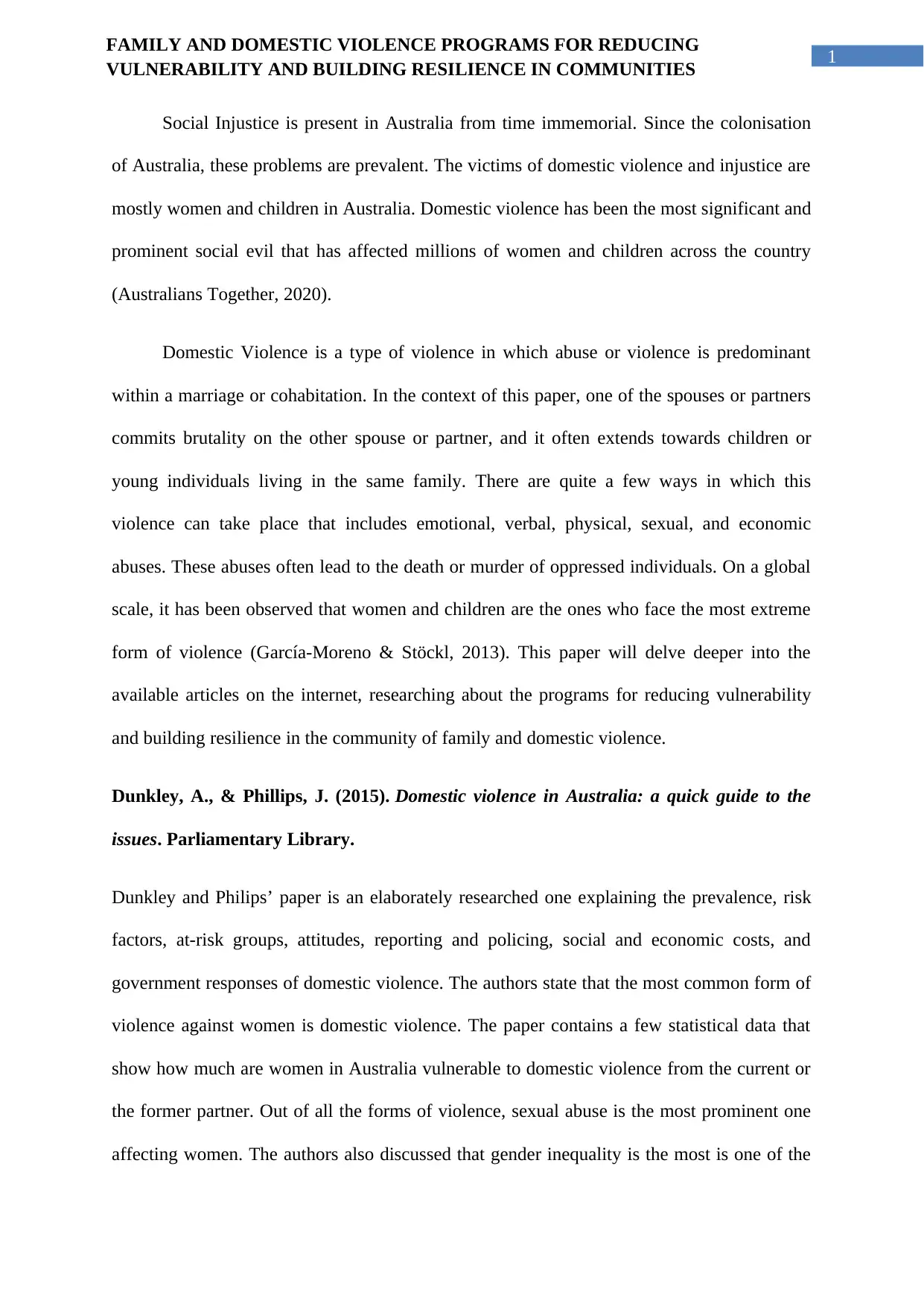
1
FAMILY AND DOMESTIC VIOLENCE PROGRAMS FOR REDUCING
VULNERABILITY AND BUILDING RESILIENCE IN COMMUNITIES
Social Injustice is present in Australia from time immemorial. Since the colonisation
of Australia, these problems are prevalent. The victims of domestic violence and injustice are
mostly women and children in Australia. Domestic violence has been the most significant and
prominent social evil that has affected millions of women and children across the country
(Australians Together, 2020).
Domestic Violence is a type of violence in which abuse or violence is predominant
within a marriage or cohabitation. In the context of this paper, one of the spouses or partners
commits brutality on the other spouse or partner, and it often extends towards children or
young individuals living in the same family. There are quite a few ways in which this
violence can take place that includes emotional, verbal, physical, sexual, and economic
abuses. These abuses often lead to the death or murder of oppressed individuals. On a global
scale, it has been observed that women and children are the ones who face the most extreme
form of violence (García-Moreno & Stöckl, 2013). This paper will delve deeper into the
available articles on the internet, researching about the programs for reducing vulnerability
and building resilience in the community of family and domestic violence.
Dunkley, A., & Phillips, J. (2015). Domestic violence in Australia: a quick guide to the
issues. Parliamentary Library.
Dunkley and Philips’ paper is an elaborately researched one explaining the prevalence, risk
factors, at-risk groups, attitudes, reporting and policing, social and economic costs, and
government responses of domestic violence. The authors state that the most common form of
violence against women is domestic violence. The paper contains a few statistical data that
show how much are women in Australia vulnerable to domestic violence from the current or
the former partner. Out of all the forms of violence, sexual abuse is the most prominent one
affecting women. The authors also discussed that gender inequality is the most is one of the
FAMILY AND DOMESTIC VIOLENCE PROGRAMS FOR REDUCING
VULNERABILITY AND BUILDING RESILIENCE IN COMMUNITIES
Social Injustice is present in Australia from time immemorial. Since the colonisation
of Australia, these problems are prevalent. The victims of domestic violence and injustice are
mostly women and children in Australia. Domestic violence has been the most significant and
prominent social evil that has affected millions of women and children across the country
(Australians Together, 2020).
Domestic Violence is a type of violence in which abuse or violence is predominant
within a marriage or cohabitation. In the context of this paper, one of the spouses or partners
commits brutality on the other spouse or partner, and it often extends towards children or
young individuals living in the same family. There are quite a few ways in which this
violence can take place that includes emotional, verbal, physical, sexual, and economic
abuses. These abuses often lead to the death or murder of oppressed individuals. On a global
scale, it has been observed that women and children are the ones who face the most extreme
form of violence (García-Moreno & Stöckl, 2013). This paper will delve deeper into the
available articles on the internet, researching about the programs for reducing vulnerability
and building resilience in the community of family and domestic violence.
Dunkley, A., & Phillips, J. (2015). Domestic violence in Australia: a quick guide to the
issues. Parliamentary Library.
Dunkley and Philips’ paper is an elaborately researched one explaining the prevalence, risk
factors, at-risk groups, attitudes, reporting and policing, social and economic costs, and
government responses of domestic violence. The authors state that the most common form of
violence against women is domestic violence. The paper contains a few statistical data that
show how much are women in Australia vulnerable to domestic violence from the current or
the former partner. Out of all the forms of violence, sexual abuse is the most prominent one
affecting women. The authors also discussed that gender inequality is the most is one of the
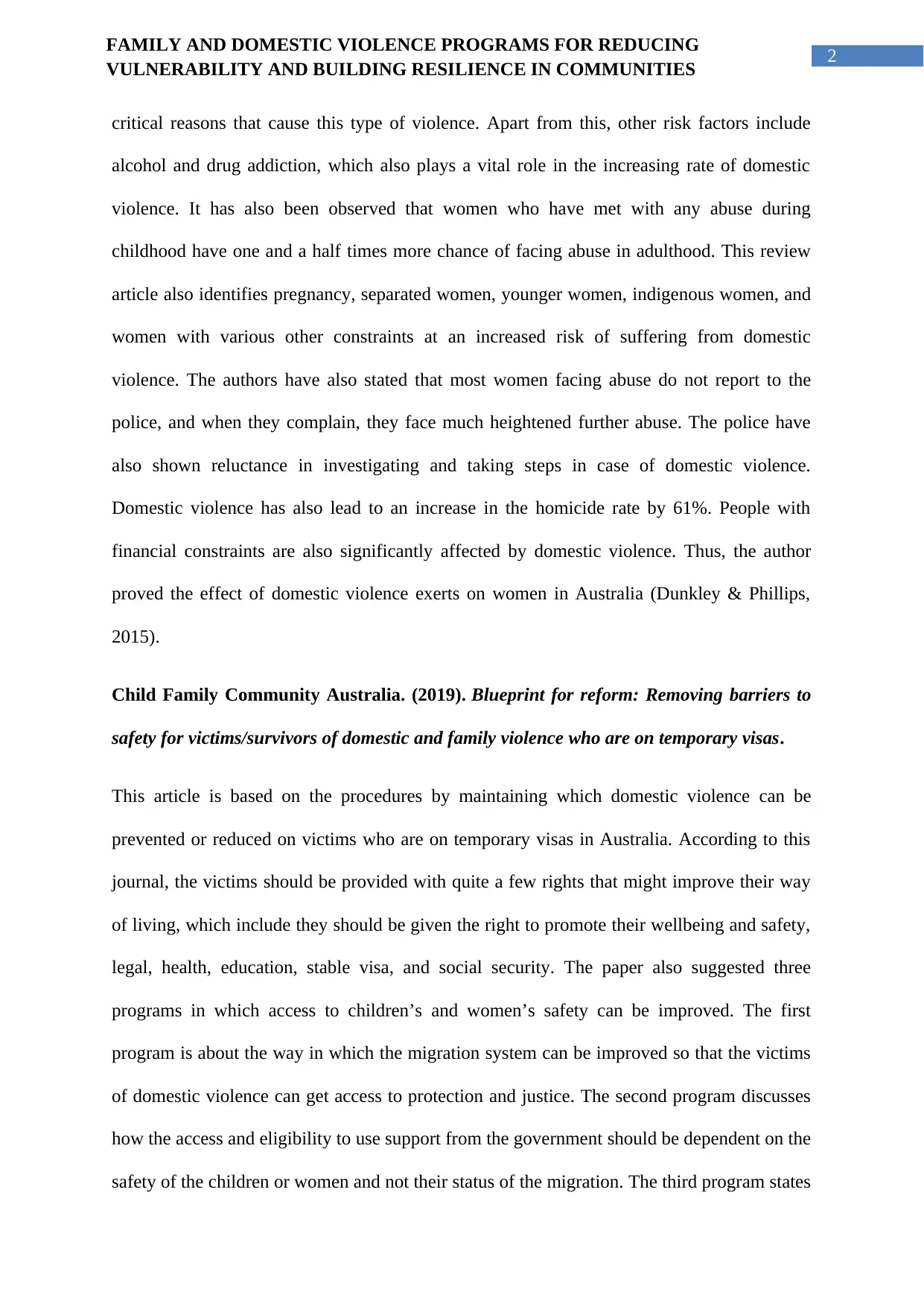
2
FAMILY AND DOMESTIC VIOLENCE PROGRAMS FOR REDUCING
VULNERABILITY AND BUILDING RESILIENCE IN COMMUNITIES
critical reasons that cause this type of violence. Apart from this, other risk factors include
alcohol and drug addiction, which also plays a vital role in the increasing rate of domestic
violence. It has also been observed that women who have met with any abuse during
childhood have one and a half times more chance of facing abuse in adulthood. This review
article also identifies pregnancy, separated women, younger women, indigenous women, and
women with various other constraints at an increased risk of suffering from domestic
violence. The authors have also stated that most women facing abuse do not report to the
police, and when they complain, they face much heightened further abuse. The police have
also shown reluctance in investigating and taking steps in case of domestic violence.
Domestic violence has also lead to an increase in the homicide rate by 61%. People with
financial constraints are also significantly affected by domestic violence. Thus, the author
proved the effect of domestic violence exerts on women in Australia (Dunkley & Phillips,
2015).
Child Family Community Australia. (2019). Blueprint for reform: Removing barriers to
safety for victims/survivors of domestic and family violence who are on temporary visas.
This article is based on the procedures by maintaining which domestic violence can be
prevented or reduced on victims who are on temporary visas in Australia. According to this
journal, the victims should be provided with quite a few rights that might improve their way
of living, which include they should be given the right to promote their wellbeing and safety,
legal, health, education, stable visa, and social security. The paper also suggested three
programs in which access to children’s and women’s safety can be improved. The first
program is about the way in which the migration system can be improved so that the victims
of domestic violence can get access to protection and justice. The second program discusses
how the access and eligibility to use support from the government should be dependent on the
safety of the children or women and not their status of the migration. The third program states
FAMILY AND DOMESTIC VIOLENCE PROGRAMS FOR REDUCING
VULNERABILITY AND BUILDING RESILIENCE IN COMMUNITIES
critical reasons that cause this type of violence. Apart from this, other risk factors include
alcohol and drug addiction, which also plays a vital role in the increasing rate of domestic
violence. It has also been observed that women who have met with any abuse during
childhood have one and a half times more chance of facing abuse in adulthood. This review
article also identifies pregnancy, separated women, younger women, indigenous women, and
women with various other constraints at an increased risk of suffering from domestic
violence. The authors have also stated that most women facing abuse do not report to the
police, and when they complain, they face much heightened further abuse. The police have
also shown reluctance in investigating and taking steps in case of domestic violence.
Domestic violence has also lead to an increase in the homicide rate by 61%. People with
financial constraints are also significantly affected by domestic violence. Thus, the author
proved the effect of domestic violence exerts on women in Australia (Dunkley & Phillips,
2015).
Child Family Community Australia. (2019). Blueprint for reform: Removing barriers to
safety for victims/survivors of domestic and family violence who are on temporary visas.
This article is based on the procedures by maintaining which domestic violence can be
prevented or reduced on victims who are on temporary visas in Australia. According to this
journal, the victims should be provided with quite a few rights that might improve their way
of living, which include they should be given the right to promote their wellbeing and safety,
legal, health, education, stable visa, and social security. The paper also suggested three
programs in which access to children’s and women’s safety can be improved. The first
program is about the way in which the migration system can be improved so that the victims
of domestic violence can get access to protection and justice. The second program discusses
how the access and eligibility to use support from the government should be dependent on the
safety of the children or women and not their status of the migration. The third program states
⊘ This is a preview!⊘
Do you want full access?
Subscribe today to unlock all pages.

Trusted by 1+ million students worldwide
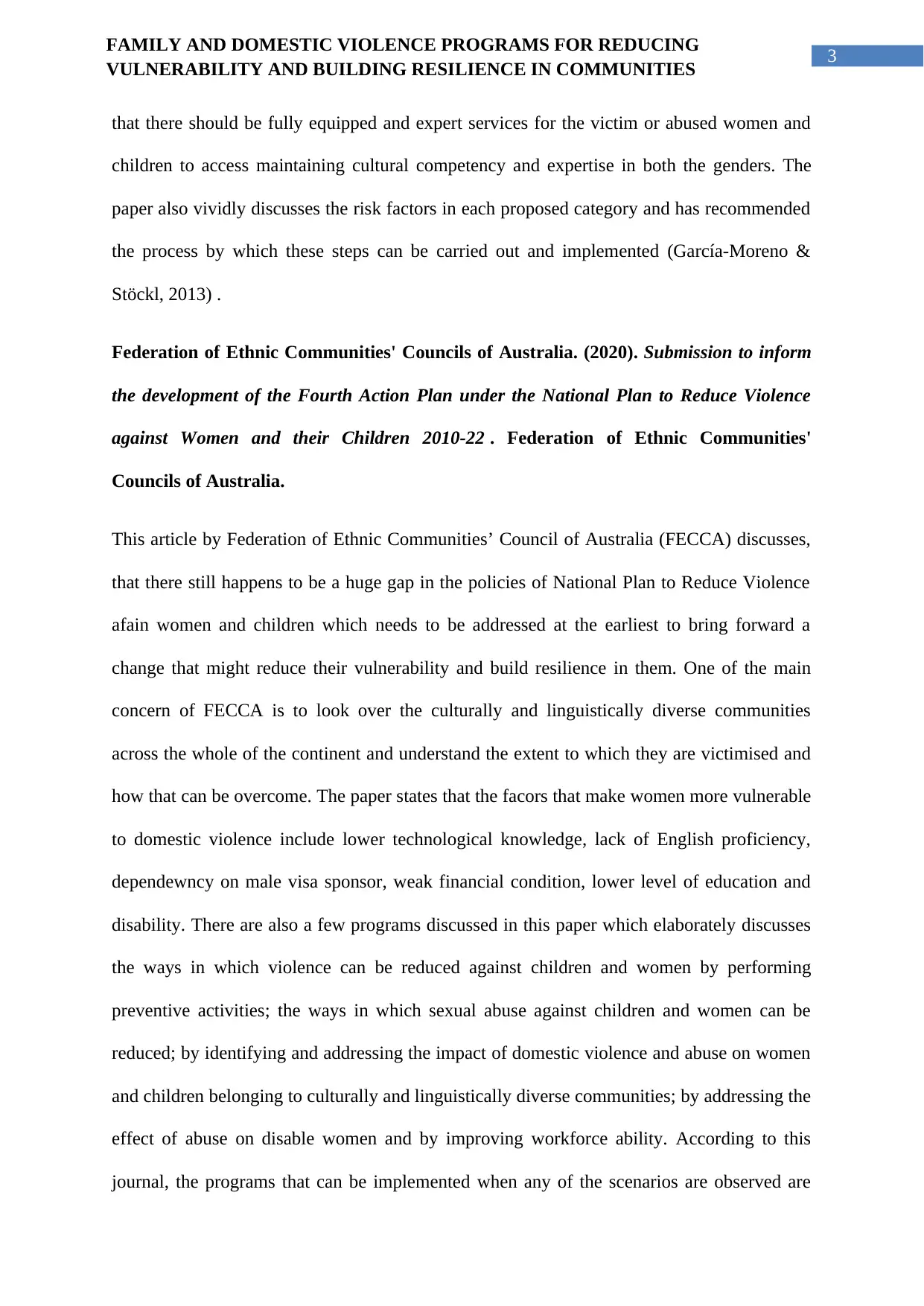
3
FAMILY AND DOMESTIC VIOLENCE PROGRAMS FOR REDUCING
VULNERABILITY AND BUILDING RESILIENCE IN COMMUNITIES
that there should be fully equipped and expert services for the victim or abused women and
children to access maintaining cultural competency and expertise in both the genders. The
paper also vividly discusses the risk factors in each proposed category and has recommended
the process by which these steps can be carried out and implemented (García-Moreno &
Stöckl, 2013) .
Federation of Ethnic Communities' Councils of Australia. (2020). Submission to inform
the development of the Fourth Action Plan under the National Plan to Reduce Violence
against Women and their Children 2010-22 . Federation of Ethnic Communities'
Councils of Australia.
This article by Federation of Ethnic Communities’ Council of Australia (FECCA) discusses,
that there still happens to be a huge gap in the policies of National Plan to Reduce Violence
afain women and children which needs to be addressed at the earliest to bring forward a
change that might reduce their vulnerability and build resilience in them. One of the main
concern of FECCA is to look over the culturally and linguistically diverse communities
across the whole of the continent and understand the extent to which they are victimised and
how that can be overcome. The paper states that the facors that make women more vulnerable
to domestic violence include lower technological knowledge, lack of English proficiency,
dependewncy on male visa sponsor, weak financial condition, lower level of education and
disability. There are also a few programs discussed in this paper which elaborately discusses
the ways in which violence can be reduced against children and women by performing
preventive activities; the ways in which sexual abuse against children and women can be
reduced; by identifying and addressing the impact of domestic violence and abuse on women
and children belonging to culturally and linguistically diverse communities; by addressing the
effect of abuse on disable women and by improving workforce ability. According to this
journal, the programs that can be implemented when any of the scenarios are observed are
FAMILY AND DOMESTIC VIOLENCE PROGRAMS FOR REDUCING
VULNERABILITY AND BUILDING RESILIENCE IN COMMUNITIES
that there should be fully equipped and expert services for the victim or abused women and
children to access maintaining cultural competency and expertise in both the genders. The
paper also vividly discusses the risk factors in each proposed category and has recommended
the process by which these steps can be carried out and implemented (García-Moreno &
Stöckl, 2013) .
Federation of Ethnic Communities' Councils of Australia. (2020). Submission to inform
the development of the Fourth Action Plan under the National Plan to Reduce Violence
against Women and their Children 2010-22 . Federation of Ethnic Communities'
Councils of Australia.
This article by Federation of Ethnic Communities’ Council of Australia (FECCA) discusses,
that there still happens to be a huge gap in the policies of National Plan to Reduce Violence
afain women and children which needs to be addressed at the earliest to bring forward a
change that might reduce their vulnerability and build resilience in them. One of the main
concern of FECCA is to look over the culturally and linguistically diverse communities
across the whole of the continent and understand the extent to which they are victimised and
how that can be overcome. The paper states that the facors that make women more vulnerable
to domestic violence include lower technological knowledge, lack of English proficiency,
dependewncy on male visa sponsor, weak financial condition, lower level of education and
disability. There are also a few programs discussed in this paper which elaborately discusses
the ways in which violence can be reduced against children and women by performing
preventive activities; the ways in which sexual abuse against children and women can be
reduced; by identifying and addressing the impact of domestic violence and abuse on women
and children belonging to culturally and linguistically diverse communities; by addressing the
effect of abuse on disable women and by improving workforce ability. According to this
journal, the programs that can be implemented when any of the scenarios are observed are
Paraphrase This Document
Need a fresh take? Get an instant paraphrase of this document with our AI Paraphraser
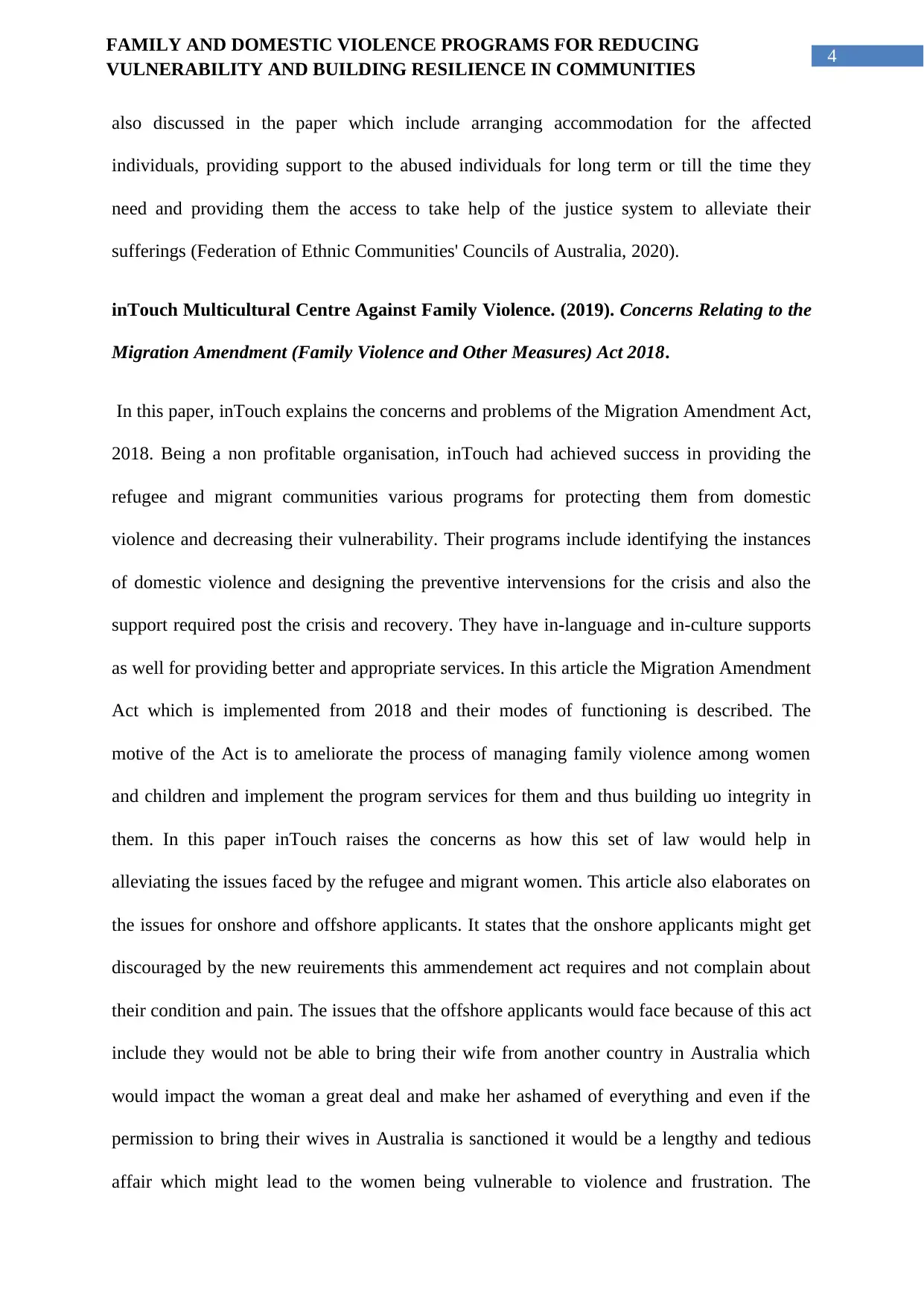
4
FAMILY AND DOMESTIC VIOLENCE PROGRAMS FOR REDUCING
VULNERABILITY AND BUILDING RESILIENCE IN COMMUNITIES
also discussed in the paper which include arranging accommodation for the affected
individuals, providing support to the abused individuals for long term or till the time they
need and providing them the access to take help of the justice system to alleviate their
sufferings (Federation of Ethnic Communities' Councils of Australia, 2020).
inTouch Multicultural Centre Against Family Violence. (2019). Concerns Relating to the
Migration Amendment (Family Violence and Other Measures) Act 2018.
In this paper, inTouch explains the concerns and problems of the Migration Amendment Act,
2018. Being a non profitable organisation, inTouch had achieved success in providing the
refugee and migrant communities various programs for protecting them from domestic
violence and decreasing their vulnerability. Their programs include identifying the instances
of domestic violence and designing the preventive intervensions for the crisis and also the
support required post the crisis and recovery. They have in-language and in-culture supports
as well for providing better and appropriate services. In this article the Migration Amendment
Act which is implemented from 2018 and their modes of functioning is described. The
motive of the Act is to ameliorate the process of managing family violence among women
and children and implement the program services for them and thus building uo integrity in
them. In this paper inTouch raises the concerns as how this set of law would help in
alleviating the issues faced by the refugee and migrant women. This article also elaborates on
the issues for onshore and offshore applicants. It states that the onshore applicants might get
discouraged by the new reuirements this ammendement act requires and not complain about
their condition and pain. The issues that the offshore applicants would face because of this act
include they would not be able to bring their wife from another country in Australia which
would impact the woman a great deal and make her ashamed of everything and even if the
permission to bring their wives in Australia is sanctioned it would be a lengthy and tedious
affair which might lead to the women being vulnerable to violence and frustration. The
FAMILY AND DOMESTIC VIOLENCE PROGRAMS FOR REDUCING
VULNERABILITY AND BUILDING RESILIENCE IN COMMUNITIES
also discussed in the paper which include arranging accommodation for the affected
individuals, providing support to the abused individuals for long term or till the time they
need and providing them the access to take help of the justice system to alleviate their
sufferings (Federation of Ethnic Communities' Councils of Australia, 2020).
inTouch Multicultural Centre Against Family Violence. (2019). Concerns Relating to the
Migration Amendment (Family Violence and Other Measures) Act 2018.
In this paper, inTouch explains the concerns and problems of the Migration Amendment Act,
2018. Being a non profitable organisation, inTouch had achieved success in providing the
refugee and migrant communities various programs for protecting them from domestic
violence and decreasing their vulnerability. Their programs include identifying the instances
of domestic violence and designing the preventive intervensions for the crisis and also the
support required post the crisis and recovery. They have in-language and in-culture supports
as well for providing better and appropriate services. In this article the Migration Amendment
Act which is implemented from 2018 and their modes of functioning is described. The
motive of the Act is to ameliorate the process of managing family violence among women
and children and implement the program services for them and thus building uo integrity in
them. In this paper inTouch raises the concerns as how this set of law would help in
alleviating the issues faced by the refugee and migrant women. This article also elaborates on
the issues for onshore and offshore applicants. It states that the onshore applicants might get
discouraged by the new reuirements this ammendement act requires and not complain about
their condition and pain. The issues that the offshore applicants would face because of this act
include they would not be able to bring their wife from another country in Australia which
would impact the woman a great deal and make her ashamed of everything and even if the
permission to bring their wives in Australia is sanctioned it would be a lengthy and tedious
affair which might lead to the women being vulnerable to violence and frustration. The
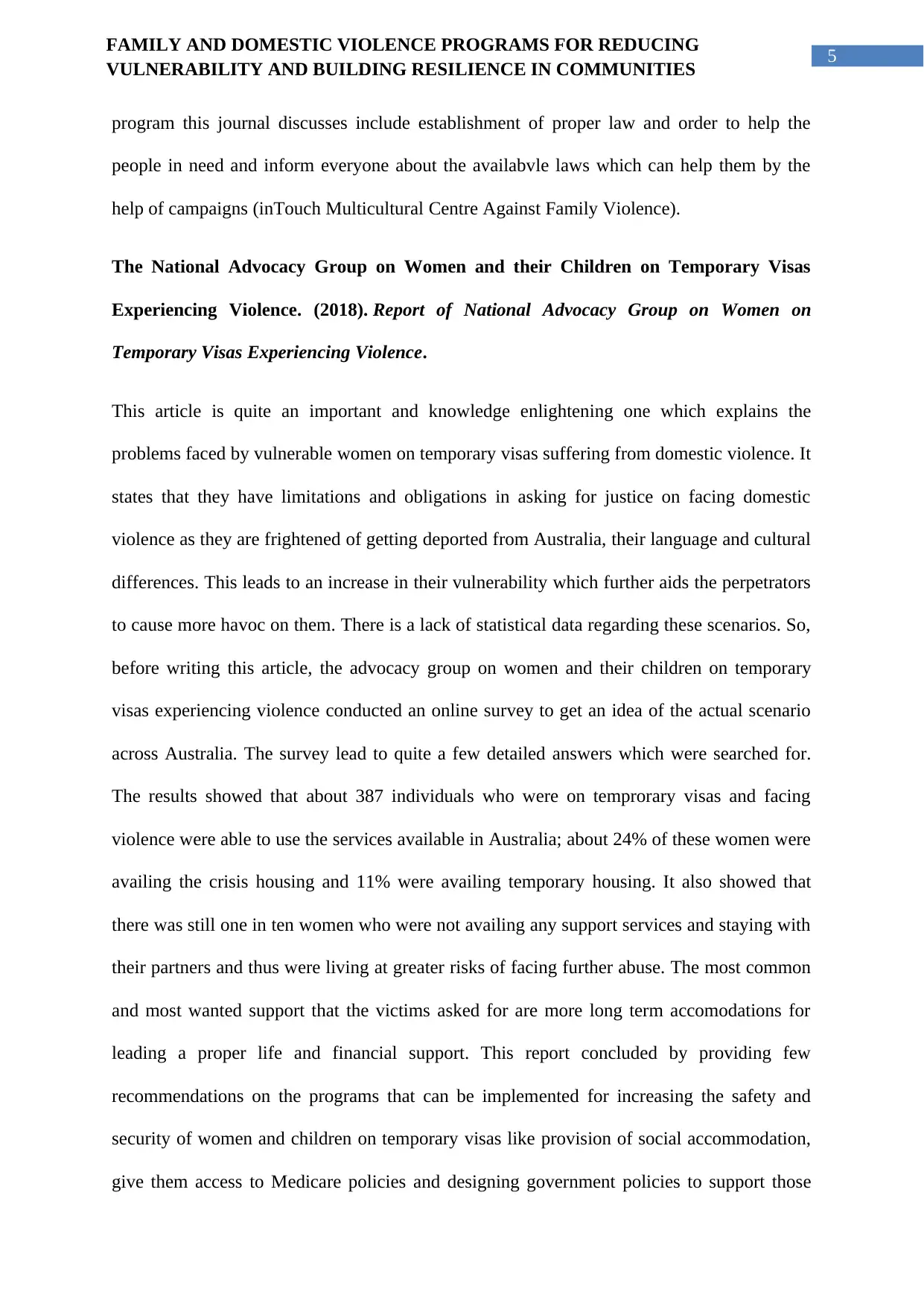
5
FAMILY AND DOMESTIC VIOLENCE PROGRAMS FOR REDUCING
VULNERABILITY AND BUILDING RESILIENCE IN COMMUNITIES
program this journal discusses include establishment of proper law and order to help the
people in need and inform everyone about the availabvle laws which can help them by the
help of campaigns (inTouch Multicultural Centre Against Family Violence).
The National Advocacy Group on Women and their Children on Temporary Visas
Experiencing Violence. (2018). Report of National Advocacy Group on Women on
Temporary Visas Experiencing Violence.
This article is quite an important and knowledge enlightening one which explains the
problems faced by vulnerable women on temporary visas suffering from domestic violence. It
states that they have limitations and obligations in asking for justice on facing domestic
violence as they are frightened of getting deported from Australia, their language and cultural
differences. This leads to an increase in their vulnerability which further aids the perpetrators
to cause more havoc on them. There is a lack of statistical data regarding these scenarios. So,
before writing this article, the advocacy group on women and their children on temporary
visas experiencing violence conducted an online survey to get an idea of the actual scenario
across Australia. The survey lead to quite a few detailed answers which were searched for.
The results showed that about 387 individuals who were on temprorary visas and facing
violence were able to use the services available in Australia; about 24% of these women were
availing the crisis housing and 11% were availing temporary housing. It also showed that
there was still one in ten women who were not availing any support services and staying with
their partners and thus were living at greater risks of facing further abuse. The most common
and most wanted support that the victims asked for are more long term accomodations for
leading a proper life and financial support. This report concluded by providing few
recommendations on the programs that can be implemented for increasing the safety and
security of women and children on temporary visas like provision of social accommodation,
give them access to Medicare policies and designing government policies to support those
FAMILY AND DOMESTIC VIOLENCE PROGRAMS FOR REDUCING
VULNERABILITY AND BUILDING RESILIENCE IN COMMUNITIES
program this journal discusses include establishment of proper law and order to help the
people in need and inform everyone about the availabvle laws which can help them by the
help of campaigns (inTouch Multicultural Centre Against Family Violence).
The National Advocacy Group on Women and their Children on Temporary Visas
Experiencing Violence. (2018). Report of National Advocacy Group on Women on
Temporary Visas Experiencing Violence.
This article is quite an important and knowledge enlightening one which explains the
problems faced by vulnerable women on temporary visas suffering from domestic violence. It
states that they have limitations and obligations in asking for justice on facing domestic
violence as they are frightened of getting deported from Australia, their language and cultural
differences. This leads to an increase in their vulnerability which further aids the perpetrators
to cause more havoc on them. There is a lack of statistical data regarding these scenarios. So,
before writing this article, the advocacy group on women and their children on temporary
visas experiencing violence conducted an online survey to get an idea of the actual scenario
across Australia. The survey lead to quite a few detailed answers which were searched for.
The results showed that about 387 individuals who were on temprorary visas and facing
violence were able to use the services available in Australia; about 24% of these women were
availing the crisis housing and 11% were availing temporary housing. It also showed that
there was still one in ten women who were not availing any support services and staying with
their partners and thus were living at greater risks of facing further abuse. The most common
and most wanted support that the victims asked for are more long term accomodations for
leading a proper life and financial support. This report concluded by providing few
recommendations on the programs that can be implemented for increasing the safety and
security of women and children on temporary visas like provision of social accommodation,
give them access to Medicare policies and designing government policies to support those
⊘ This is a preview!⊘
Do you want full access?
Subscribe today to unlock all pages.

Trusted by 1+ million students worldwide
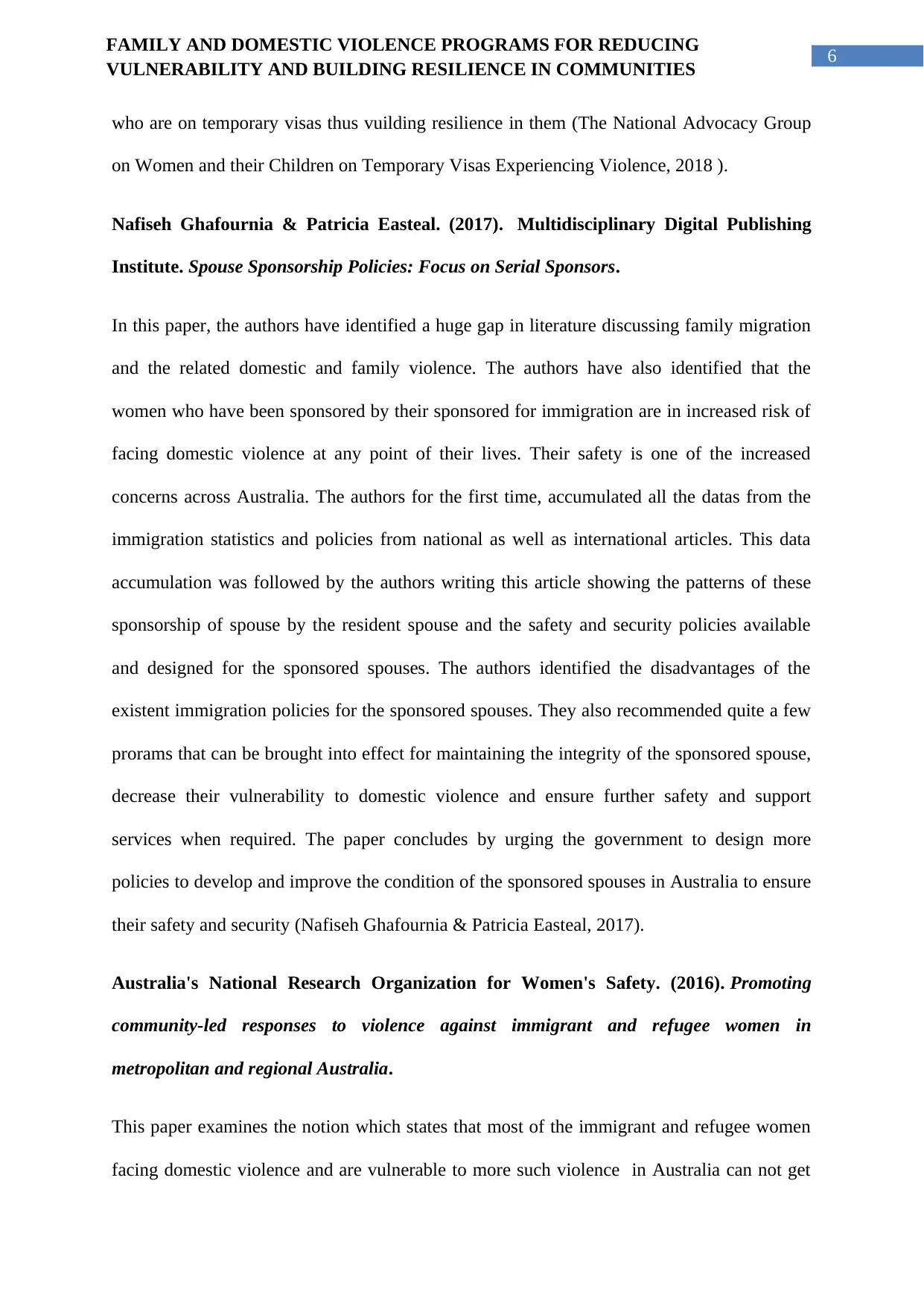
6
FAMILY AND DOMESTIC VIOLENCE PROGRAMS FOR REDUCING
VULNERABILITY AND BUILDING RESILIENCE IN COMMUNITIES
who are on temporary visas thus vuilding resilience in them (The National Advocacy Group
on Women and their Children on Temporary Visas Experiencing Violence, 2018 ).
Nafiseh Ghafournia & Patricia Easteal. (2017). Multidisciplinary Digital Publishing
Institute. Spouse Sponsorship Policies: Focus on Serial Sponsors.
In this paper, the authors have identified a huge gap in literature discussing family migration
and the related domestic and family violence. The authors have also identified that the
women who have been sponsored by their sponsored for immigration are in increased risk of
facing domestic violence at any point of their lives. Their safety is one of the increased
concerns across Australia. The authors for the first time, accumulated all the datas from the
immigration statistics and policies from national as well as international articles. This data
accumulation was followed by the authors writing this article showing the patterns of these
sponsorship of spouse by the resident spouse and the safety and security policies available
and designed for the sponsored spouses. The authors identified the disadvantages of the
existent immigration policies for the sponsored spouses. They also recommended quite a few
prorams that can be brought into effect for maintaining the integrity of the sponsored spouse,
decrease their vulnerability to domestic violence and ensure further safety and support
services when required. The paper concludes by urging the government to design more
policies to develop and improve the condition of the sponsored spouses in Australia to ensure
their safety and security (Nafiseh Ghafournia & Patricia Easteal, 2017).
Australia's National Research Organization for Women's Safety. (2016). Promoting
community-led responses to violence against immigrant and refugee women in
metropolitan and regional Australia.
This paper examines the notion which states that most of the immigrant and refugee women
facing domestic violence and are vulnerable to more such violence in Australia can not get
FAMILY AND DOMESTIC VIOLENCE PROGRAMS FOR REDUCING
VULNERABILITY AND BUILDING RESILIENCE IN COMMUNITIES
who are on temporary visas thus vuilding resilience in them (The National Advocacy Group
on Women and their Children on Temporary Visas Experiencing Violence, 2018 ).
Nafiseh Ghafournia & Patricia Easteal. (2017). Multidisciplinary Digital Publishing
Institute. Spouse Sponsorship Policies: Focus on Serial Sponsors.
In this paper, the authors have identified a huge gap in literature discussing family migration
and the related domestic and family violence. The authors have also identified that the
women who have been sponsored by their sponsored for immigration are in increased risk of
facing domestic violence at any point of their lives. Their safety is one of the increased
concerns across Australia. The authors for the first time, accumulated all the datas from the
immigration statistics and policies from national as well as international articles. This data
accumulation was followed by the authors writing this article showing the patterns of these
sponsorship of spouse by the resident spouse and the safety and security policies available
and designed for the sponsored spouses. The authors identified the disadvantages of the
existent immigration policies for the sponsored spouses. They also recommended quite a few
prorams that can be brought into effect for maintaining the integrity of the sponsored spouse,
decrease their vulnerability to domestic violence and ensure further safety and support
services when required. The paper concludes by urging the government to design more
policies to develop and improve the condition of the sponsored spouses in Australia to ensure
their safety and security (Nafiseh Ghafournia & Patricia Easteal, 2017).
Australia's National Research Organization for Women's Safety. (2016). Promoting
community-led responses to violence against immigrant and refugee women in
metropolitan and regional Australia.
This paper examines the notion which states that most of the immigrant and refugee women
facing domestic violence and are vulnerable to more such violence in Australia can not get
Paraphrase This Document
Need a fresh take? Get an instant paraphrase of this document with our AI Paraphraser
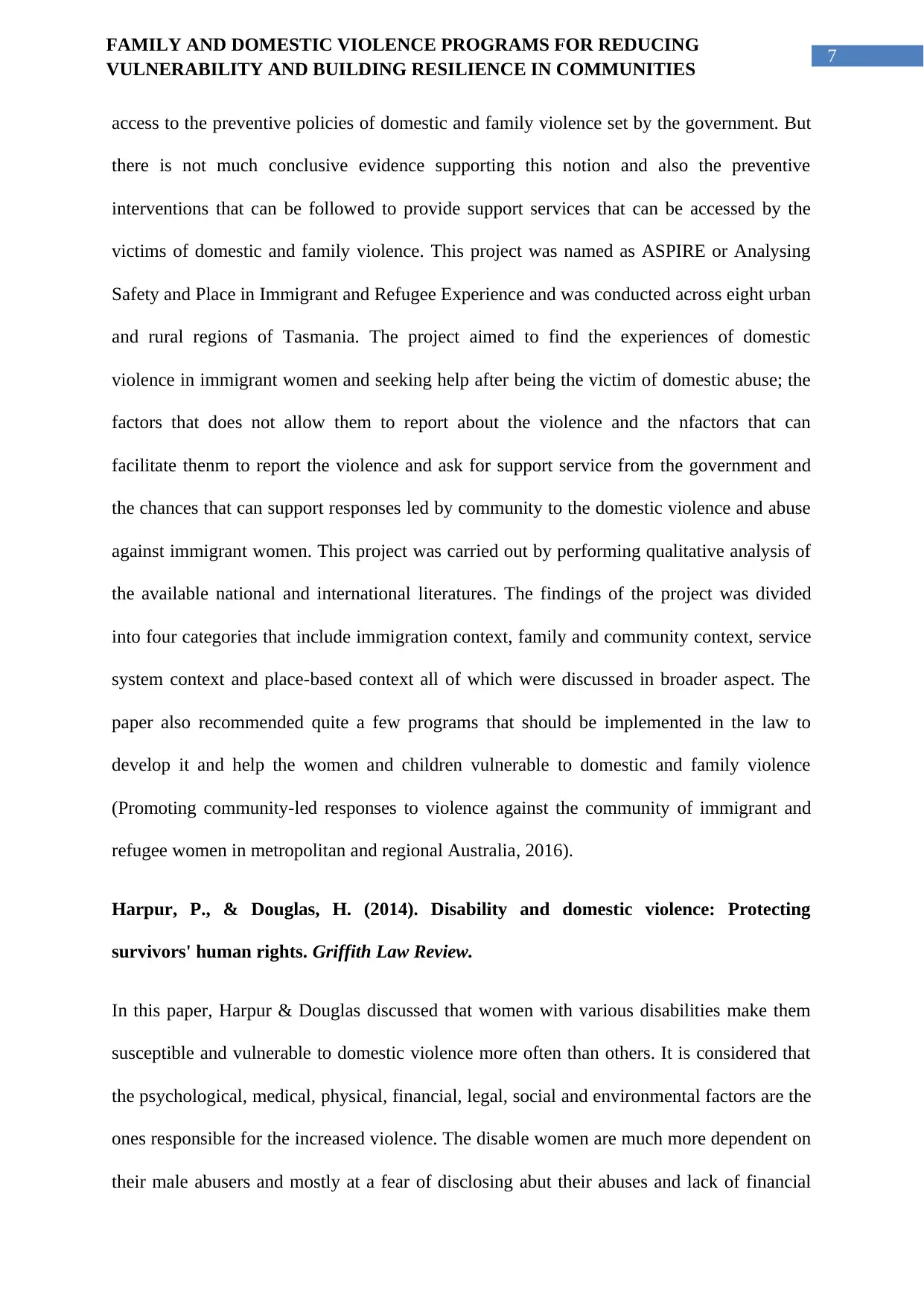
7
FAMILY AND DOMESTIC VIOLENCE PROGRAMS FOR REDUCING
VULNERABILITY AND BUILDING RESILIENCE IN COMMUNITIES
access to the preventive policies of domestic and family violence set by the government. But
there is not much conclusive evidence supporting this notion and also the preventive
interventions that can be followed to provide support services that can be accessed by the
victims of domestic and family violence. This project was named as ASPIRE or Analysing
Safety and Place in Immigrant and Refugee Experience and was conducted across eight urban
and rural regions of Tasmania. The project aimed to find the experiences of domestic
violence in immigrant women and seeking help after being the victim of domestic abuse; the
factors that does not allow them to report about the violence and the nfactors that can
facilitate thenm to report the violence and ask for support service from the government and
the chances that can support responses led by community to the domestic violence and abuse
against immigrant women. This project was carried out by performing qualitative analysis of
the available national and international literatures. The findings of the project was divided
into four categories that include immigration context, family and community context, service
system context and place-based context all of which were discussed in broader aspect. The
paper also recommended quite a few programs that should be implemented in the law to
develop it and help the women and children vulnerable to domestic and family violence
(Promoting community-led responses to violence against the community of immigrant and
refugee women in metropolitan and regional Australia, 2016).
Harpur, P., & Douglas, H. (2014). Disability and domestic violence: Protecting
survivors' human rights. Griffith Law Review.
In this paper, Harpur & Douglas discussed that women with various disabilities make them
susceptible and vulnerable to domestic violence more often than others. It is considered that
the psychological, medical, physical, financial, legal, social and environmental factors are the
ones responsible for the increased violence. The disable women are much more dependent on
their male abusers and mostly at a fear of disclosing abut their abuses and lack of financial
FAMILY AND DOMESTIC VIOLENCE PROGRAMS FOR REDUCING
VULNERABILITY AND BUILDING RESILIENCE IN COMMUNITIES
access to the preventive policies of domestic and family violence set by the government. But
there is not much conclusive evidence supporting this notion and also the preventive
interventions that can be followed to provide support services that can be accessed by the
victims of domestic and family violence. This project was named as ASPIRE or Analysing
Safety and Place in Immigrant and Refugee Experience and was conducted across eight urban
and rural regions of Tasmania. The project aimed to find the experiences of domestic
violence in immigrant women and seeking help after being the victim of domestic abuse; the
factors that does not allow them to report about the violence and the nfactors that can
facilitate thenm to report the violence and ask for support service from the government and
the chances that can support responses led by community to the domestic violence and abuse
against immigrant women. This project was carried out by performing qualitative analysis of
the available national and international literatures. The findings of the project was divided
into four categories that include immigration context, family and community context, service
system context and place-based context all of which were discussed in broader aspect. The
paper also recommended quite a few programs that should be implemented in the law to
develop it and help the women and children vulnerable to domestic and family violence
(Promoting community-led responses to violence against the community of immigrant and
refugee women in metropolitan and regional Australia, 2016).
Harpur, P., & Douglas, H. (2014). Disability and domestic violence: Protecting
survivors' human rights. Griffith Law Review.
In this paper, Harpur & Douglas discussed that women with various disabilities make them
susceptible and vulnerable to domestic violence more often than others. It is considered that
the psychological, medical, physical, financial, legal, social and environmental factors are the
ones responsible for the increased violence. The disable women are much more dependent on
their male abusers and mostly at a fear of disclosing abut their abuses and lack of financial
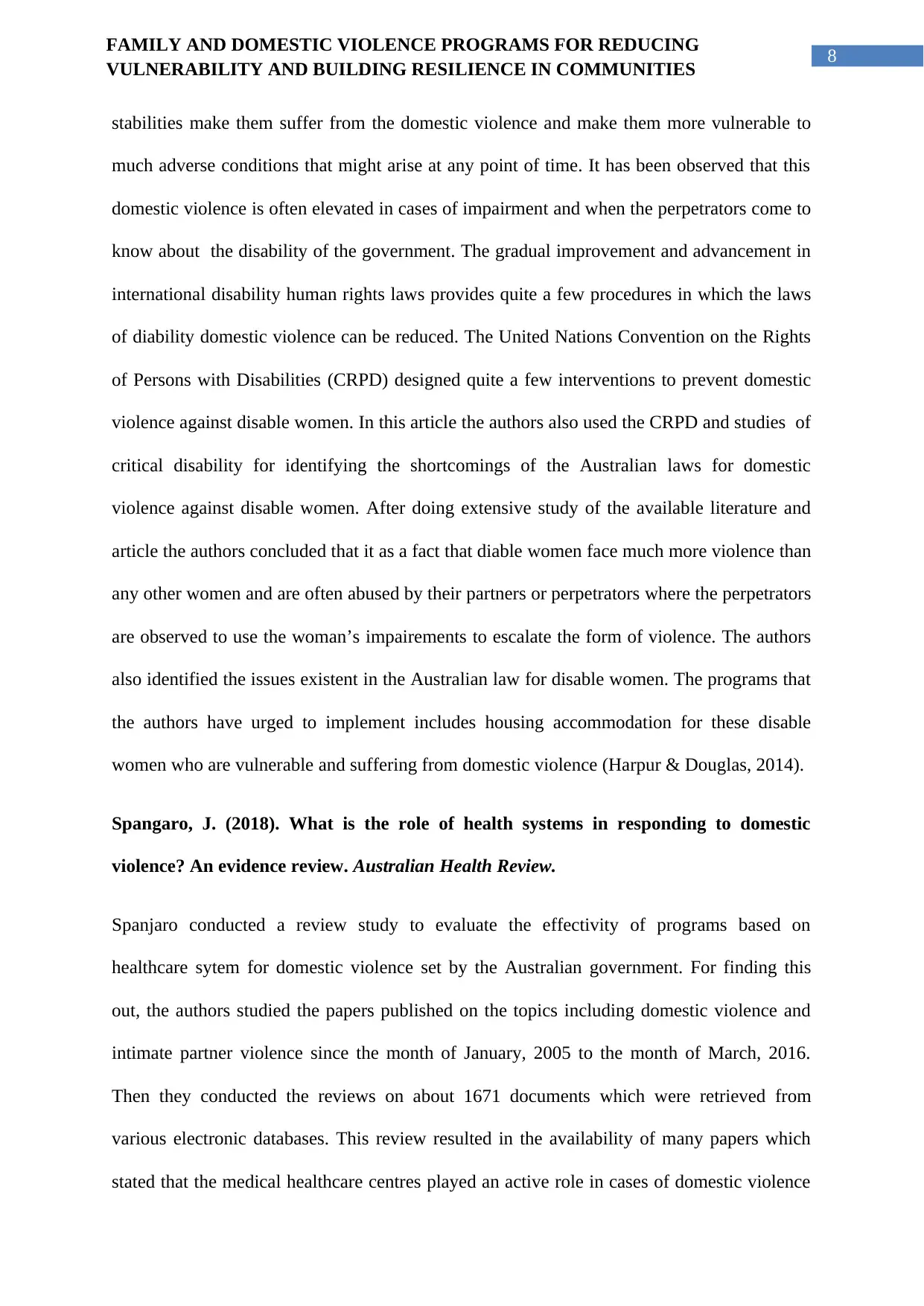
8
FAMILY AND DOMESTIC VIOLENCE PROGRAMS FOR REDUCING
VULNERABILITY AND BUILDING RESILIENCE IN COMMUNITIES
stabilities make them suffer from the domestic violence and make them more vulnerable to
much adverse conditions that might arise at any point of time. It has been observed that this
domestic violence is often elevated in cases of impairment and when the perpetrators come to
know about the disability of the government. The gradual improvement and advancement in
international disability human rights laws provides quite a few procedures in which the laws
of diability domestic violence can be reduced. The United Nations Convention on the Rights
of Persons with Disabilities (CRPD) designed quite a few interventions to prevent domestic
violence against disable women. In this article the authors also used the CRPD and studies of
critical disability for identifying the shortcomings of the Australian laws for domestic
violence against disable women. After doing extensive study of the available literature and
article the authors concluded that it as a fact that diable women face much more violence than
any other women and are often abused by their partners or perpetrators where the perpetrators
are observed to use the woman’s impairements to escalate the form of violence. The authors
also identified the issues existent in the Australian law for disable women. The programs that
the authors have urged to implement includes housing accommodation for these disable
women who are vulnerable and suffering from domestic violence (Harpur & Douglas, 2014).
Spangaro, J. (2018). What is the role of health systems in responding to domestic
violence? An evidence review. Australian Health Review.
Spanjaro conducted a review study to evaluate the effectivity of programs based on
healthcare sytem for domestic violence set by the Australian government. For finding this
out, the authors studied the papers published on the topics including domestic violence and
intimate partner violence since the month of January, 2005 to the month of March, 2016.
Then they conducted the reviews on about 1671 documents which were retrieved from
various electronic databases. This review resulted in the availability of many papers which
stated that the medical healthcare centres played an active role in cases of domestic violence
FAMILY AND DOMESTIC VIOLENCE PROGRAMS FOR REDUCING
VULNERABILITY AND BUILDING RESILIENCE IN COMMUNITIES
stabilities make them suffer from the domestic violence and make them more vulnerable to
much adverse conditions that might arise at any point of time. It has been observed that this
domestic violence is often elevated in cases of impairment and when the perpetrators come to
know about the disability of the government. The gradual improvement and advancement in
international disability human rights laws provides quite a few procedures in which the laws
of diability domestic violence can be reduced. The United Nations Convention on the Rights
of Persons with Disabilities (CRPD) designed quite a few interventions to prevent domestic
violence against disable women. In this article the authors also used the CRPD and studies of
critical disability for identifying the shortcomings of the Australian laws for domestic
violence against disable women. After doing extensive study of the available literature and
article the authors concluded that it as a fact that diable women face much more violence than
any other women and are often abused by their partners or perpetrators where the perpetrators
are observed to use the woman’s impairements to escalate the form of violence. The authors
also identified the issues existent in the Australian law for disable women. The programs that
the authors have urged to implement includes housing accommodation for these disable
women who are vulnerable and suffering from domestic violence (Harpur & Douglas, 2014).
Spangaro, J. (2018). What is the role of health systems in responding to domestic
violence? An evidence review. Australian Health Review.
Spanjaro conducted a review study to evaluate the effectivity of programs based on
healthcare sytem for domestic violence set by the Australian government. For finding this
out, the authors studied the papers published on the topics including domestic violence and
intimate partner violence since the month of January, 2005 to the month of March, 2016.
Then they conducted the reviews on about 1671 documents which were retrieved from
various electronic databases. This review resulted in the availability of many papers which
stated that the medical healthcare centres played an active role in cases of domestic violence
⊘ This is a preview!⊘
Do you want full access?
Subscribe today to unlock all pages.

Trusted by 1+ million students worldwide
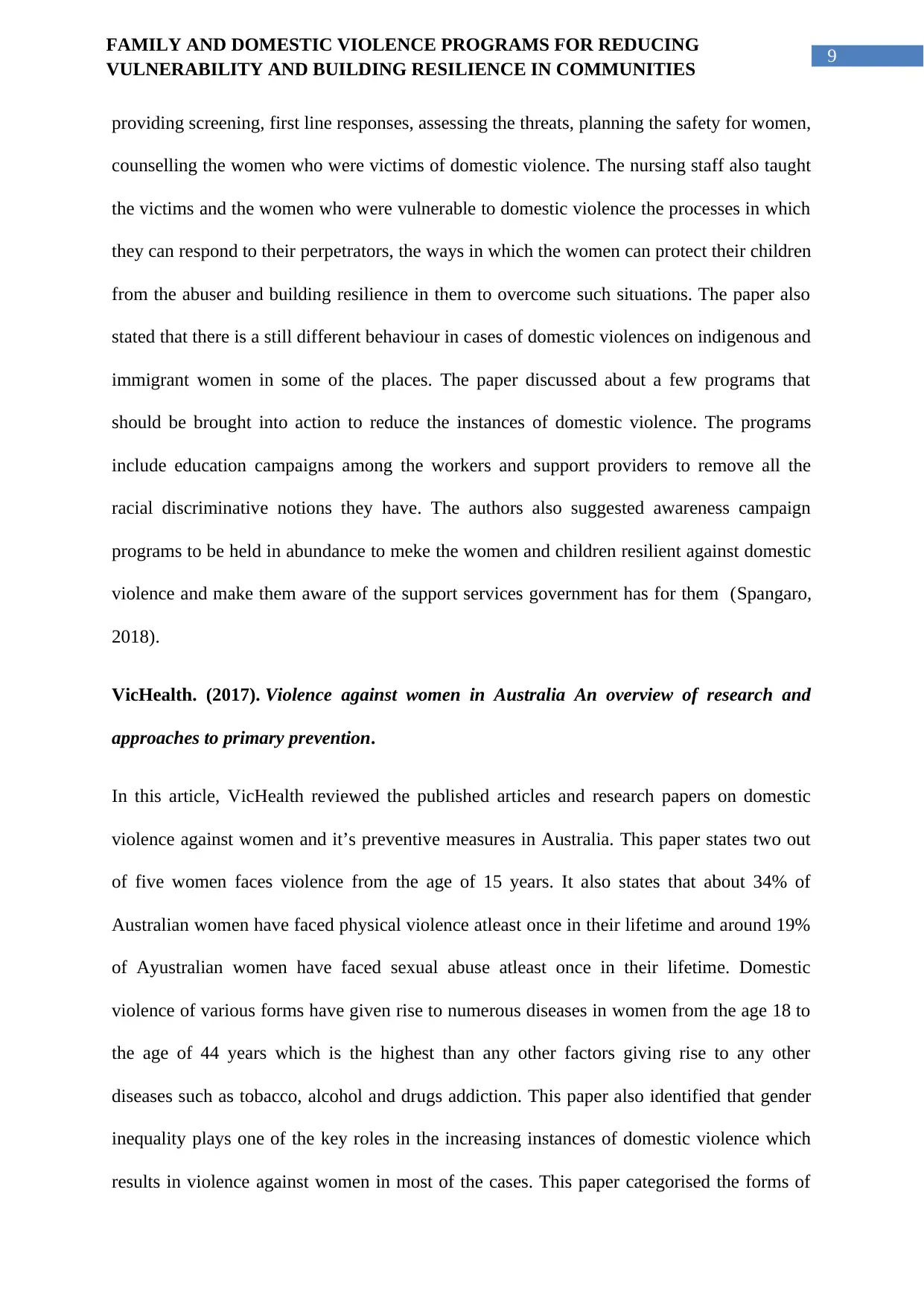
9
FAMILY AND DOMESTIC VIOLENCE PROGRAMS FOR REDUCING
VULNERABILITY AND BUILDING RESILIENCE IN COMMUNITIES
providing screening, first line responses, assessing the threats, planning the safety for women,
counselling the women who were victims of domestic violence. The nursing staff also taught
the victims and the women who were vulnerable to domestic violence the processes in which
they can respond to their perpetrators, the ways in which the women can protect their children
from the abuser and building resilience in them to overcome such situations. The paper also
stated that there is a still different behaviour in cases of domestic violences on indigenous and
immigrant women in some of the places. The paper discussed about a few programs that
should be brought into action to reduce the instances of domestic violence. The programs
include education campaigns among the workers and support providers to remove all the
racial discriminative notions they have. The authors also suggested awareness campaign
programs to be held in abundance to meke the women and children resilient against domestic
violence and make them aware of the support services government has for them (Spangaro,
2018).
VicHealth. (2017). Violence against women in Australia An overview of research and
approaches to primary prevention.
In this article, VicHealth reviewed the published articles and research papers on domestic
violence against women and it’s preventive measures in Australia. This paper states two out
of five women faces violence from the age of 15 years. It also states that about 34% of
Australian women have faced physical violence atleast once in their lifetime and around 19%
of Ayustralian women have faced sexual abuse atleast once in their lifetime. Domestic
violence of various forms have given rise to numerous diseases in women from the age 18 to
the age of 44 years which is the highest than any other factors giving rise to any other
diseases such as tobacco, alcohol and drugs addiction. This paper also identified that gender
inequality plays one of the key roles in the increasing instances of domestic violence which
results in violence against women in most of the cases. This paper categorised the forms of
FAMILY AND DOMESTIC VIOLENCE PROGRAMS FOR REDUCING
VULNERABILITY AND BUILDING RESILIENCE IN COMMUNITIES
providing screening, first line responses, assessing the threats, planning the safety for women,
counselling the women who were victims of domestic violence. The nursing staff also taught
the victims and the women who were vulnerable to domestic violence the processes in which
they can respond to their perpetrators, the ways in which the women can protect their children
from the abuser and building resilience in them to overcome such situations. The paper also
stated that there is a still different behaviour in cases of domestic violences on indigenous and
immigrant women in some of the places. The paper discussed about a few programs that
should be brought into action to reduce the instances of domestic violence. The programs
include education campaigns among the workers and support providers to remove all the
racial discriminative notions they have. The authors also suggested awareness campaign
programs to be held in abundance to meke the women and children resilient against domestic
violence and make them aware of the support services government has for them (Spangaro,
2018).
VicHealth. (2017). Violence against women in Australia An overview of research and
approaches to primary prevention.
In this article, VicHealth reviewed the published articles and research papers on domestic
violence against women and it’s preventive measures in Australia. This paper states two out
of five women faces violence from the age of 15 years. It also states that about 34% of
Australian women have faced physical violence atleast once in their lifetime and around 19%
of Ayustralian women have faced sexual abuse atleast once in their lifetime. Domestic
violence of various forms have given rise to numerous diseases in women from the age 18 to
the age of 44 years which is the highest than any other factors giving rise to any other
diseases such as tobacco, alcohol and drugs addiction. This paper also identified that gender
inequality plays one of the key roles in the increasing instances of domestic violence which
results in violence against women in most of the cases. This paper categorised the forms of
Paraphrase This Document
Need a fresh take? Get an instant paraphrase of this document with our AI Paraphraser
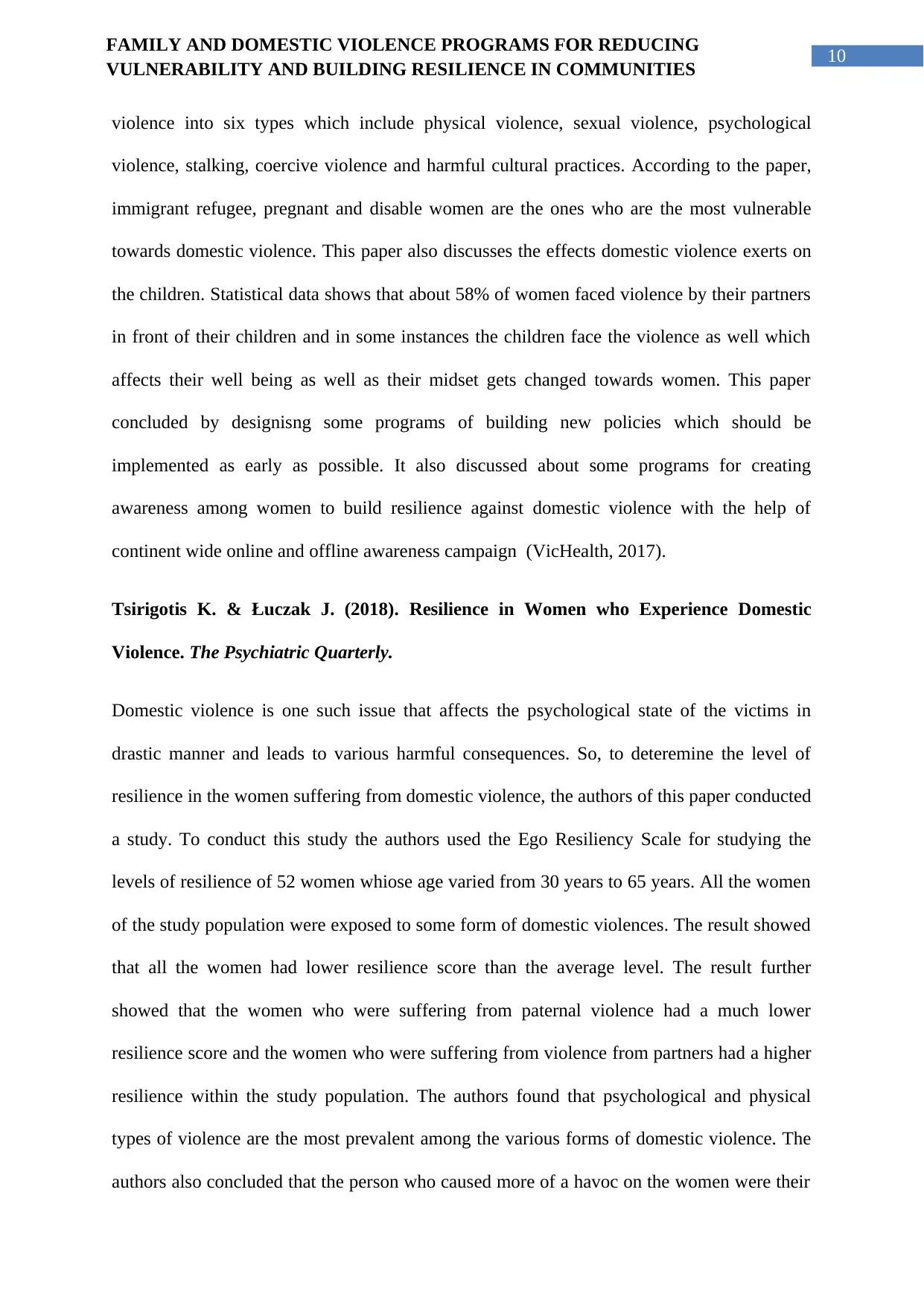
10
FAMILY AND DOMESTIC VIOLENCE PROGRAMS FOR REDUCING
VULNERABILITY AND BUILDING RESILIENCE IN COMMUNITIES
violence into six types which include physical violence, sexual violence, psychological
violence, stalking, coercive violence and harmful cultural practices. According to the paper,
immigrant refugee, pregnant and disable women are the ones who are the most vulnerable
towards domestic violence. This paper also discusses the effects domestic violence exerts on
the children. Statistical data shows that about 58% of women faced violence by their partners
in front of their children and in some instances the children face the violence as well which
affects their well being as well as their midset gets changed towards women. This paper
concluded by designisng some programs of building new policies which should be
implemented as early as possible. It also discussed about some programs for creating
awareness among women to build resilience against domestic violence with the help of
continent wide online and offline awareness campaign (VicHealth, 2017).
Tsirigotis K. & Łuczak J. (2018). Resilience in Women who Experience Domestic
Violence. The Psychiatric Quarterly.
Domestic violence is one such issue that affects the psychological state of the victims in
drastic manner and leads to various harmful consequences. So, to deteremine the level of
resilience in the women suffering from domestic violence, the authors of this paper conducted
a study. To conduct this study the authors used the Ego Resiliency Scale for studying the
levels of resilience of 52 women whiose age varied from 30 years to 65 years. All the women
of the study population were exposed to some form of domestic violences. The result showed
that all the women had lower resilience score than the average level. The result further
showed that the women who were suffering from paternal violence had a much lower
resilience score and the women who were suffering from violence from partners had a higher
resilience within the study population. The authors found that psychological and physical
types of violence are the most prevalent among the various forms of domestic violence. The
authors also concluded that the person who caused more of a havoc on the women were their
FAMILY AND DOMESTIC VIOLENCE PROGRAMS FOR REDUCING
VULNERABILITY AND BUILDING RESILIENCE IN COMMUNITIES
violence into six types which include physical violence, sexual violence, psychological
violence, stalking, coercive violence and harmful cultural practices. According to the paper,
immigrant refugee, pregnant and disable women are the ones who are the most vulnerable
towards domestic violence. This paper also discusses the effects domestic violence exerts on
the children. Statistical data shows that about 58% of women faced violence by their partners
in front of their children and in some instances the children face the violence as well which
affects their well being as well as their midset gets changed towards women. This paper
concluded by designisng some programs of building new policies which should be
implemented as early as possible. It also discussed about some programs for creating
awareness among women to build resilience against domestic violence with the help of
continent wide online and offline awareness campaign (VicHealth, 2017).
Tsirigotis K. & Łuczak J. (2018). Resilience in Women who Experience Domestic
Violence. The Psychiatric Quarterly.
Domestic violence is one such issue that affects the psychological state of the victims in
drastic manner and leads to various harmful consequences. So, to deteremine the level of
resilience in the women suffering from domestic violence, the authors of this paper conducted
a study. To conduct this study the authors used the Ego Resiliency Scale for studying the
levels of resilience of 52 women whiose age varied from 30 years to 65 years. All the women
of the study population were exposed to some form of domestic violences. The result showed
that all the women had lower resilience score than the average level. The result further
showed that the women who were suffering from paternal violence had a much lower
resilience score and the women who were suffering from violence from partners had a higher
resilience within the study population. The authors found that psychological and physical
types of violence are the most prevalent among the various forms of domestic violence. The
authors also concluded that the person who caused more of a havoc on the women were their
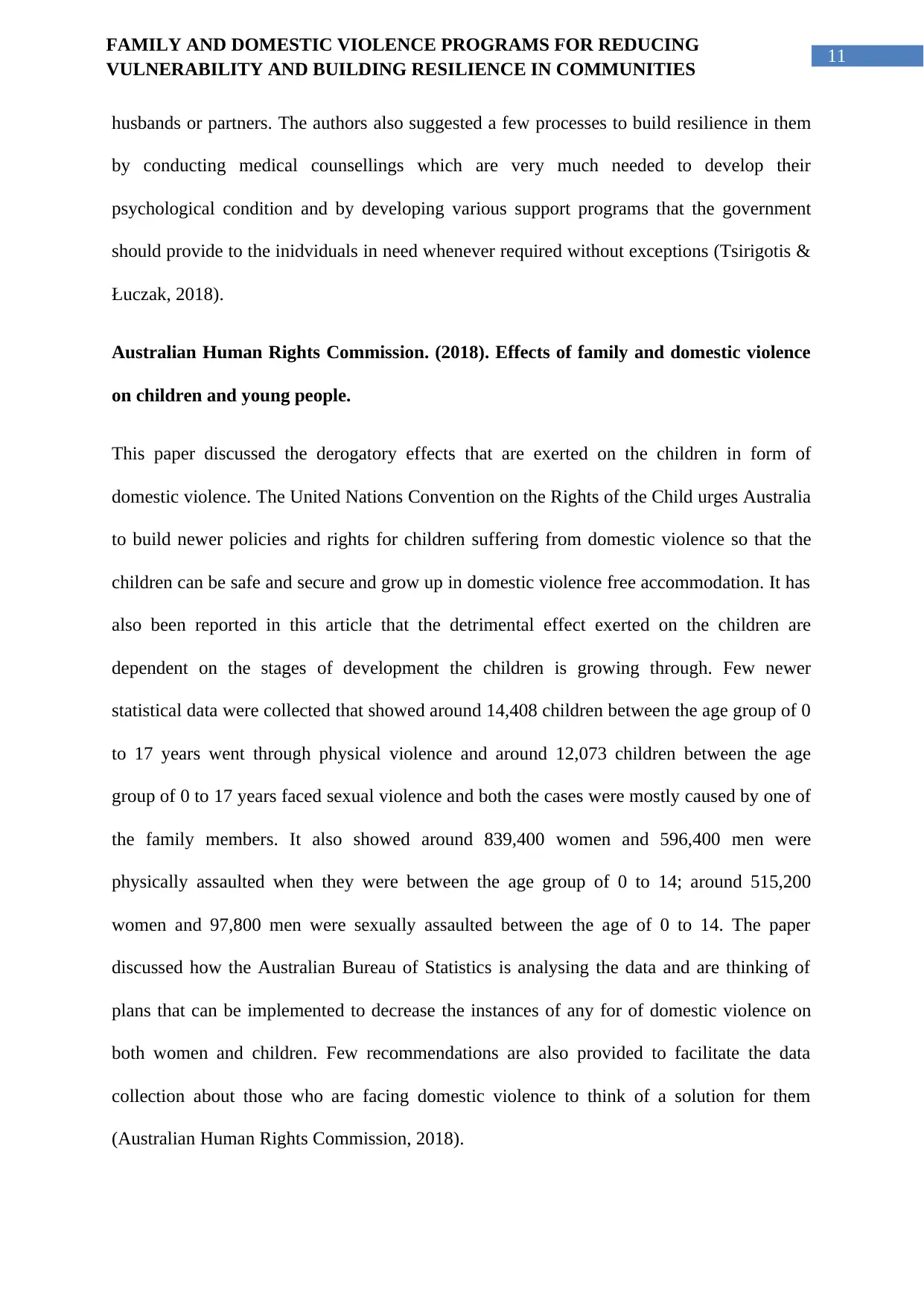
11
FAMILY AND DOMESTIC VIOLENCE PROGRAMS FOR REDUCING
VULNERABILITY AND BUILDING RESILIENCE IN COMMUNITIES
husbands or partners. The authors also suggested a few processes to build resilience in them
by conducting medical counsellings which are very much needed to develop their
psychological condition and by developing various support programs that the government
should provide to the inidviduals in need whenever required without exceptions (Tsirigotis &
Łuczak, 2018).
Australian Human Rights Commission. (2018). Effects of family and domestic violence
on children and young people.
This paper discussed the derogatory effects that are exerted on the children in form of
domestic violence. The United Nations Convention on the Rights of the Child urges Australia
to build newer policies and rights for children suffering from domestic violence so that the
children can be safe and secure and grow up in domestic violence free accommodation. It has
also been reported in this article that the detrimental effect exerted on the children are
dependent on the stages of development the children is growing through. Few newer
statistical data were collected that showed around 14,408 children between the age group of 0
to 17 years went through physical violence and around 12,073 children between the age
group of 0 to 17 years faced sexual violence and both the cases were mostly caused by one of
the family members. It also showed around 839,400 women and 596,400 men were
physically assaulted when they were between the age group of 0 to 14; around 515,200
women and 97,800 men were sexually assaulted between the age of 0 to 14. The paper
discussed how the Australian Bureau of Statistics is analysing the data and are thinking of
plans that can be implemented to decrease the instances of any for of domestic violence on
both women and children. Few recommendations are also provided to facilitate the data
collection about those who are facing domestic violence to think of a solution for them
(Australian Human Rights Commission, 2018).
FAMILY AND DOMESTIC VIOLENCE PROGRAMS FOR REDUCING
VULNERABILITY AND BUILDING RESILIENCE IN COMMUNITIES
husbands or partners. The authors also suggested a few processes to build resilience in them
by conducting medical counsellings which are very much needed to develop their
psychological condition and by developing various support programs that the government
should provide to the inidviduals in need whenever required without exceptions (Tsirigotis &
Łuczak, 2018).
Australian Human Rights Commission. (2018). Effects of family and domestic violence
on children and young people.
This paper discussed the derogatory effects that are exerted on the children in form of
domestic violence. The United Nations Convention on the Rights of the Child urges Australia
to build newer policies and rights for children suffering from domestic violence so that the
children can be safe and secure and grow up in domestic violence free accommodation. It has
also been reported in this article that the detrimental effect exerted on the children are
dependent on the stages of development the children is growing through. Few newer
statistical data were collected that showed around 14,408 children between the age group of 0
to 17 years went through physical violence and around 12,073 children between the age
group of 0 to 17 years faced sexual violence and both the cases were mostly caused by one of
the family members. It also showed around 839,400 women and 596,400 men were
physically assaulted when they were between the age group of 0 to 14; around 515,200
women and 97,800 men were sexually assaulted between the age of 0 to 14. The paper
discussed how the Australian Bureau of Statistics is analysing the data and are thinking of
plans that can be implemented to decrease the instances of any for of domestic violence on
both women and children. Few recommendations are also provided to facilitate the data
collection about those who are facing domestic violence to think of a solution for them
(Australian Human Rights Commission, 2018).
⊘ This is a preview!⊘
Do you want full access?
Subscribe today to unlock all pages.

Trusted by 1+ million students worldwide
1 out of 21
Related Documents
Your All-in-One AI-Powered Toolkit for Academic Success.
+13062052269
info@desklib.com
Available 24*7 on WhatsApp / Email
![[object Object]](/_next/static/media/star-bottom.7253800d.svg)
Unlock your academic potential
Copyright © 2020–2025 A2Z Services. All Rights Reserved. Developed and managed by ZUCOL.





